CS 208 s20 — Virtual Memory: Optimization
Table of Contents
1 Video
Here is a video lecture for the material outlined below. It covers CSPP section 9.6 (p. 813–824). It contains sections on
- introduction (0:03)
- page hit/miss review (0:58)
- permissions (9:30)
- TLBs (18:12)
- bringing it all together (25:15)
- multi-level page tables (35:34)
- virtual memory worksheet overview (45:40)
- conclusion (49:46)
The Panopto viewer has table of contents entries for these sections. Link to the Panopto viewer: https://carleton.hosted.panopto.com/Panopto/Pages/Viewer.aspx?id=9f4528f8-dbbd-4145-8954-abcf01089a4b
3 Protection
- want to enforce things like read-only code and kernel-only memory
- page table permission bits natural way to do this
- extend page table to include read/write/execute bits
- MMU checks them on every memory access
- if violated, raises exception and kernel sends SIGSEGV (segmentation fault) signal to process
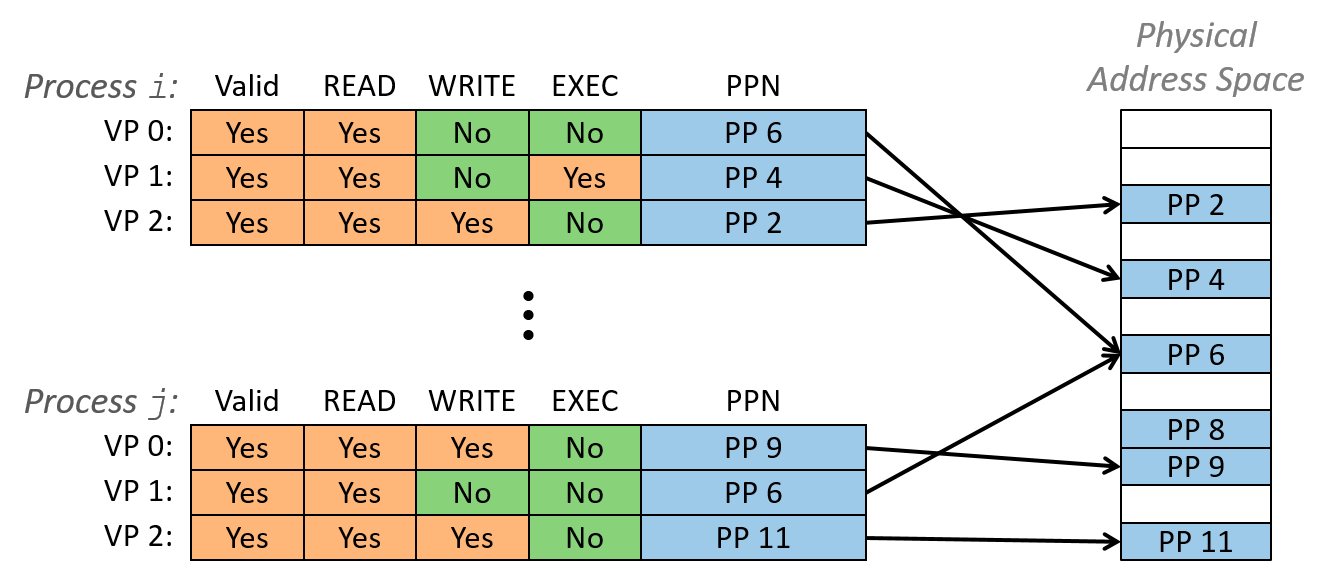
3.1 Permissions Review
| Section | Read | Write | Execute |
|---|---|---|---|
| Stack | 1 | 1 | 0 |
| Heap | 1 | 1 | 0 |
| Static Data | 1 | 1 | 0 |
| Literals | 1 | 0 | 0 |
| Instructions | 1 | 0 | 1 |
4 Improving Performance
4.1 Translation Lookaside Buffer (TLB)
- MMU has to access memory twice: once to get the PTE, and again for the actual memory request
- we can speed up address translation via a small cache of page table entries (called a translation lookaside buffer (TLB)
- VPN split into tag and index for this cache
- modern Intel processors have 128 or 256 entries in TLB
- we can speed up address translation via a small cache of page table entries (called a translation lookaside buffer (TLB)


4.2 Bringing It All Together
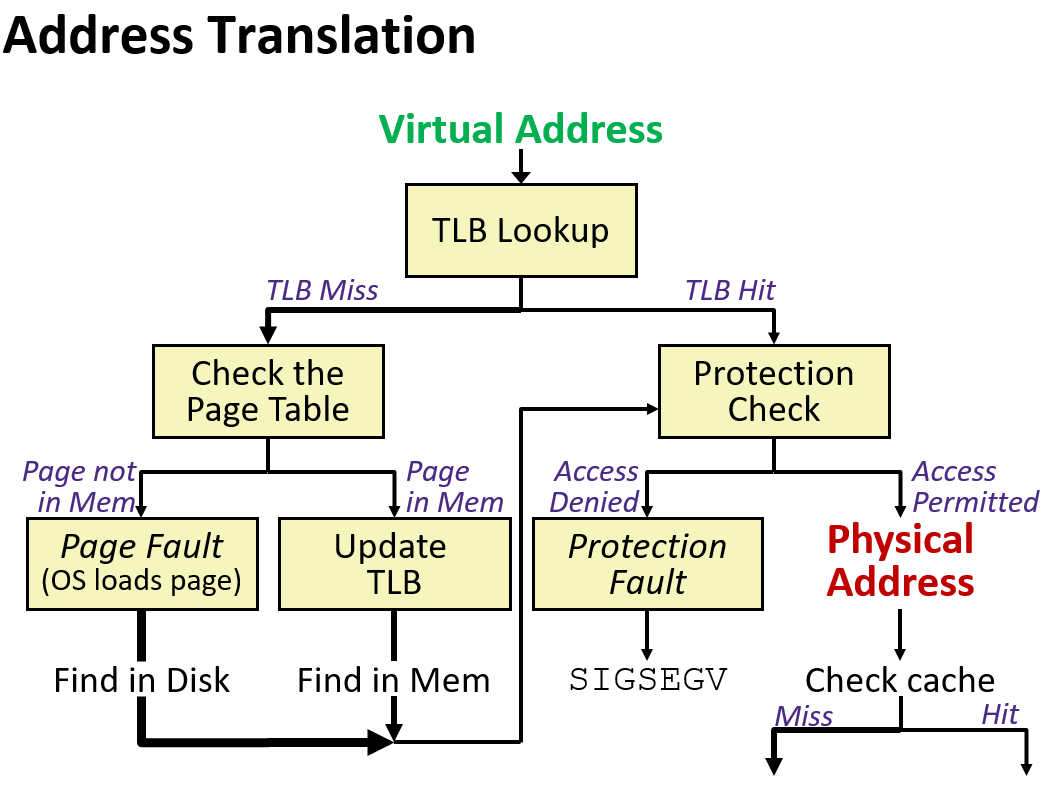

- Basic Parameters
- \(N=2^n\) — Number of addresses in virtual address space
- \(M=2^m\) — Number of addresses in physical address space
- \(P=2^p\) — Page size (bytes)
- Components of the virtual address (VA)
- VPO — Virtual page offset
- VPN — Virtual page number
- TLBI — TLB index
- TLBT — TLB tag
- Components of the physical address (PA)
- PPO — Physical page offset (same as VPO)
- PPN — Physical page number
4.3 Multi-Level Page Tables
- suppose 64-bit virtual addresses (\(n=64\)), 8 KB pages (\(p=13\)), 8 GB physical memory (\(m=33\))
- how many page table entries? 2n-p = 251
- how many bits per PTE? PPN width + management bits = \(m - p + 5\) (valid, dirty, read, write, execute) = 25 bits or about 3 bytes
- we can't actually have 4 million GB worth of page table entries for each process
- we can use multi-level page tables to reduce memory overhead
- VPN split into \(k\) segments, one for each level of page table
- instead of a million page table entries in memory, most unused, we have have a level 1 table with 1000 entries, and then only have a second level of 1000 for allocated level 1 entries
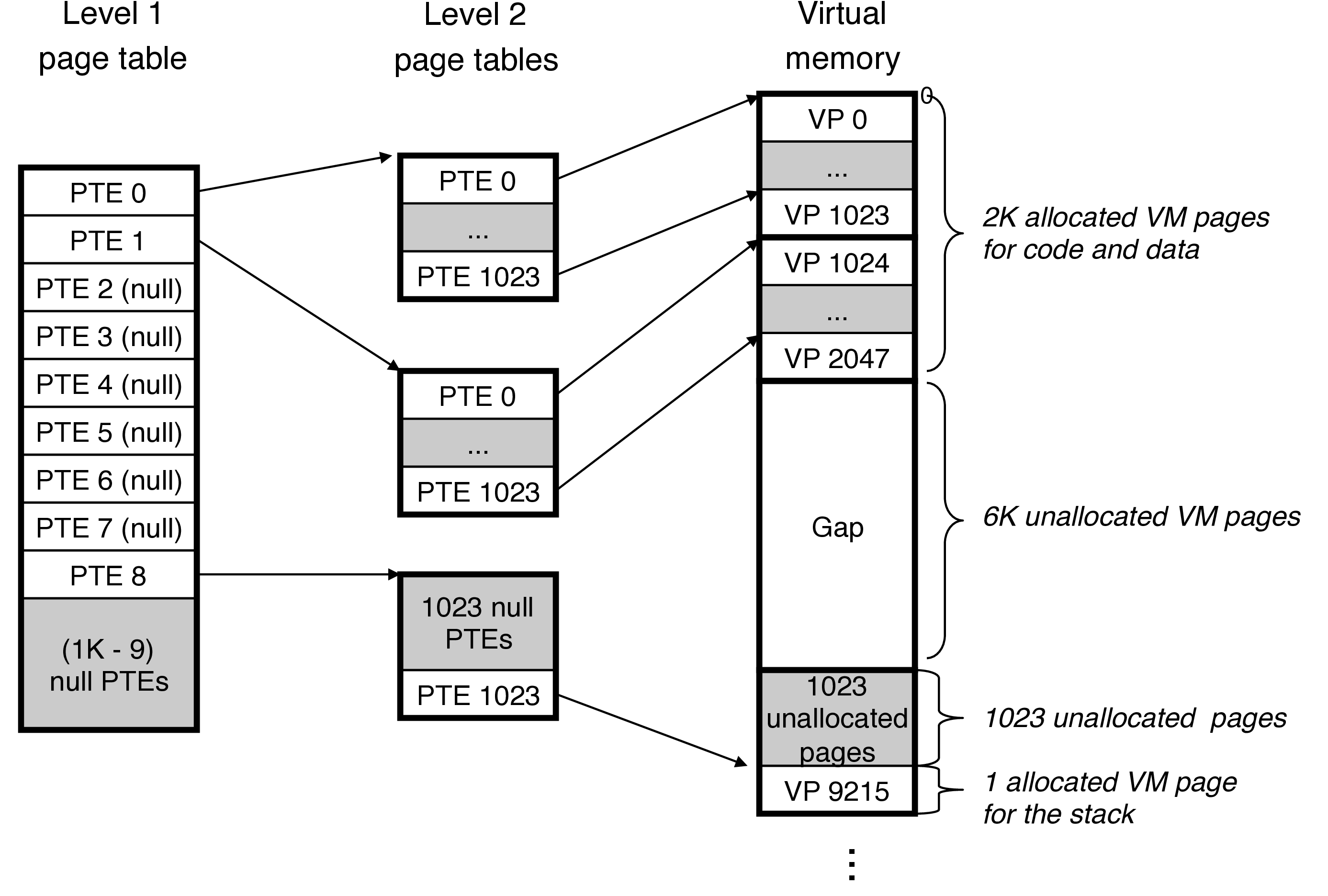
5 Extended Example
Below is background for the virtual memory worksheet assigned as this topic's homework.
- addressing:
- 14-bit virtual addresses
- 12-bit physical addresses
- 64-byte pages
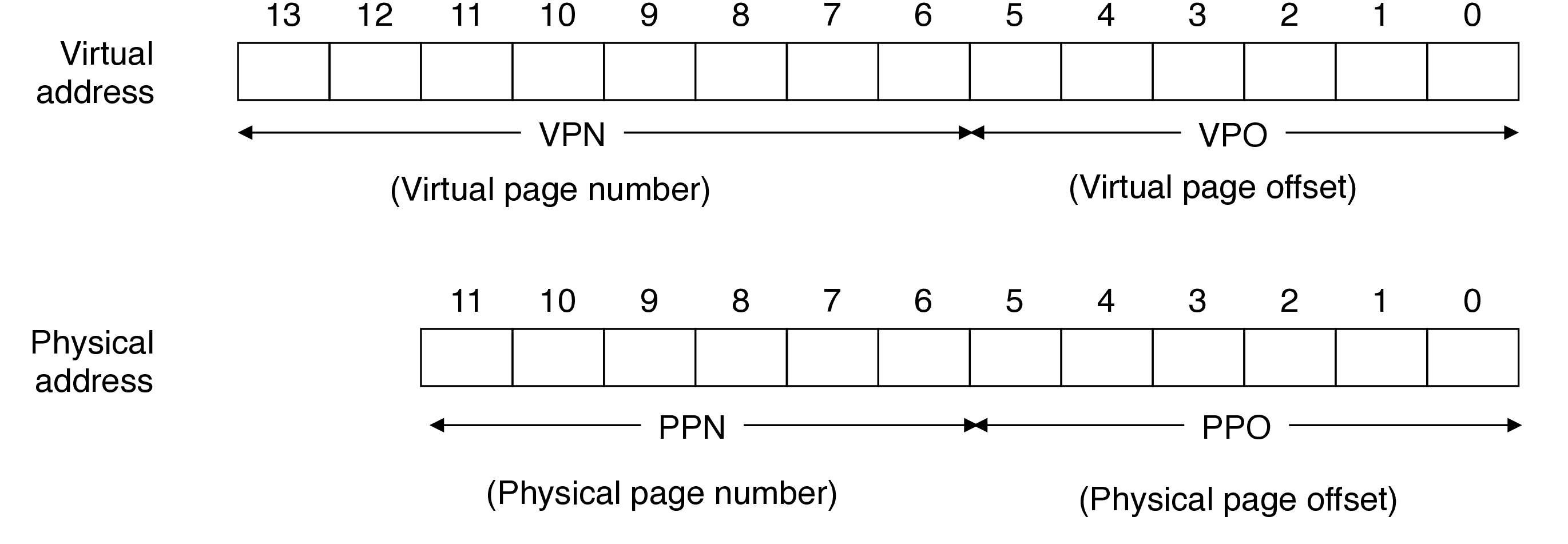
- page table
- only showing first 16 entries (out of how many? one for every virtual page = \(2^{n-p} = 2^8 = 256\))
- using 2 hex digits for PPN even though it's only 6 bits
- other management bits not shown
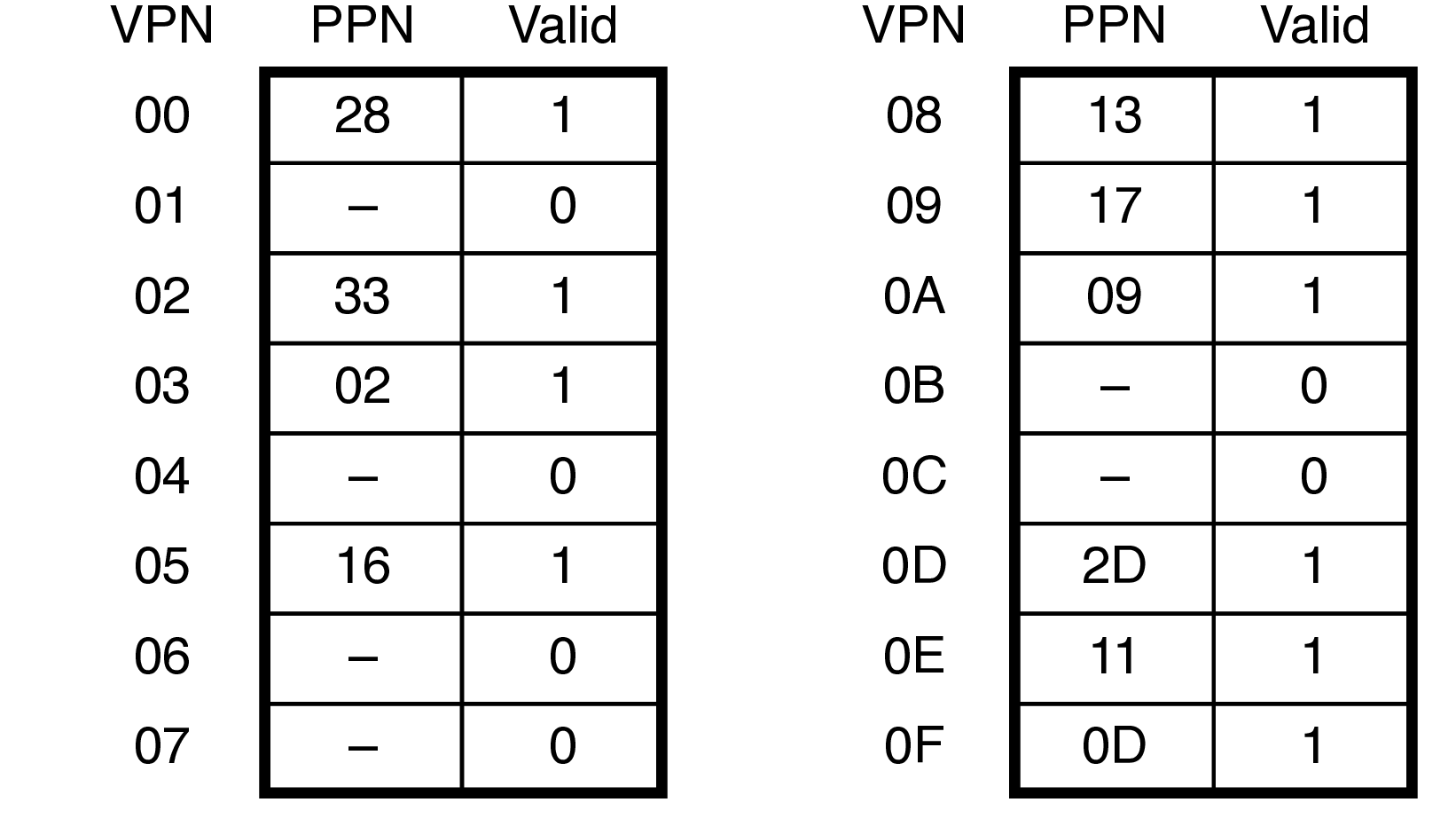
- translation lookaside buffer
- 16 entries
- 4-way associative
- VPN split into TLB tag (TLBT) and TLB index (TLBI)

- cache
- direct-mapped with 4-byte blocks
- total capacity of 64 bytes (16 blocks)
- physically addressed
- physical address split into cache tag (CT), cache index (CI) and cache offset (CO)
- just a coincidence that PPN is the same width as the cache tag
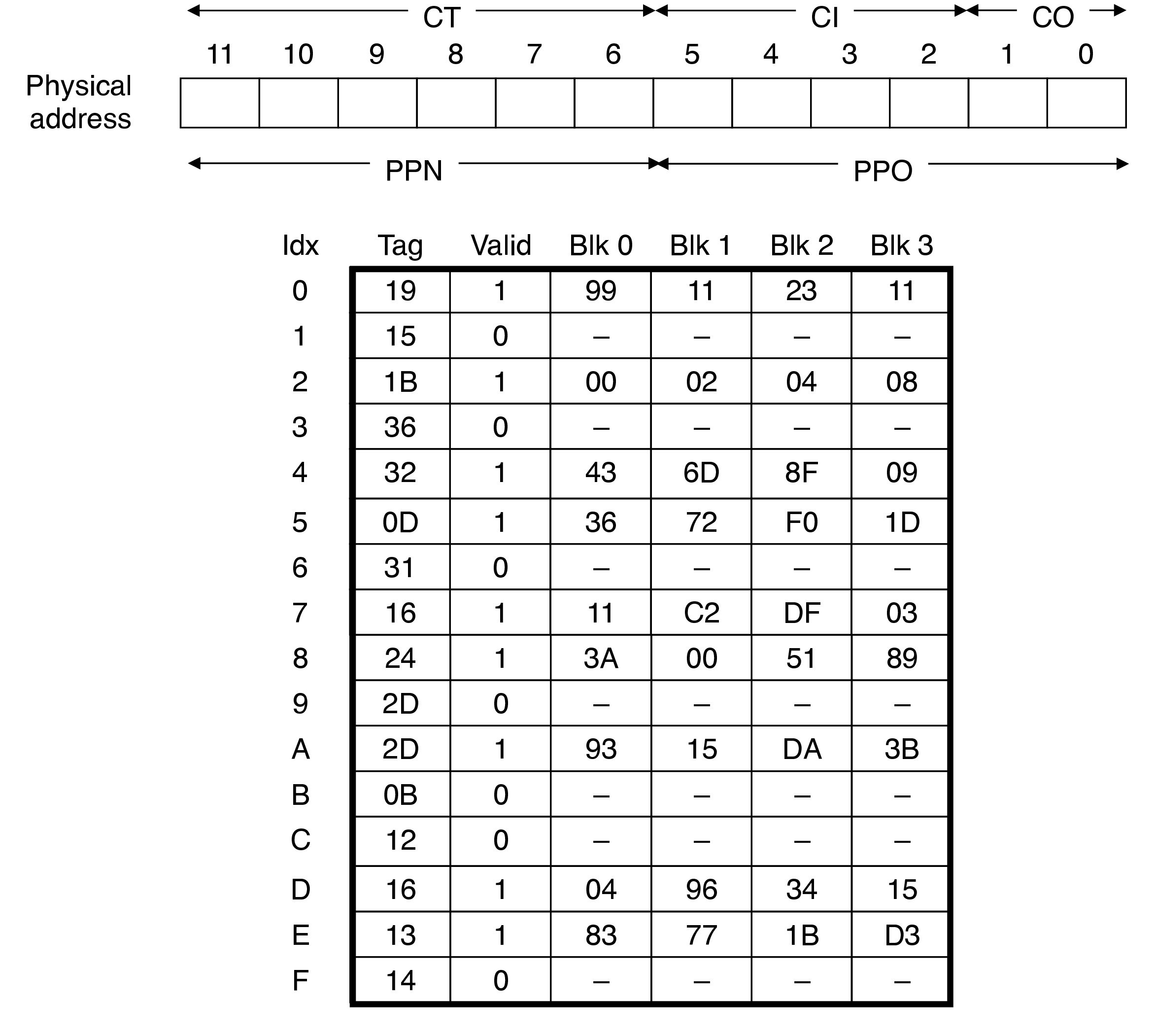
6 Homework
- Virtual memory worksheet (solutions below3)
- The week 8 quiz is due 9pm tonight, June 3 (it's very short!)
- Make a lab 5 check-in forum post by 9pm tonight, June 3
Footnotes:
1

- processor sends virtual address to MMU
- MMU requests page table entry (PTE) from page table in cache/memory
- using page table base register (PTBR) to find beginning of page table for current process
- PTE sent to MMU
- MMU send physical address to cache/memory requesting data
- cache/memory sends data to processor
2

- processor sends virtual address to MMU
- MMU requests page table entry (PTE) from page table in cache/memory
- PTE sent to MMU
- valid bit is zero, MMU triggers page fault exception
- page fault handler (an operating system function) identifies page to evict
- if modified (dirty) write out (page out) to disk
- handler loads (pages in) new page, updates PTE in memory
- handler returns to original process, restarting faulting instruction
3
| Request | VPN | TLBT | TLBI | TLB hit? | page fault? | PPN | CT | CI | CO | cache hit? | data (byte) |
0x03d4 |
0x0f |
0x03 |
3 |
yes | no | 0x0d |
0x0d |
5 |
0 |
yes | 0x36 |
0x038f |
0x0e |
0x03 |
2 |
no | yes | - | - | - | - | - | - |
0x0020 |
0x00 |
0x00 |
0 |
no | no | 0x28 |
0x28 |
8 |
0 |
no | - |
0x036b |
0x0d |
0x03 |
1 |
yes | no | 0x2d |
0x2d |
a |
3 |
yes | 0x3b |